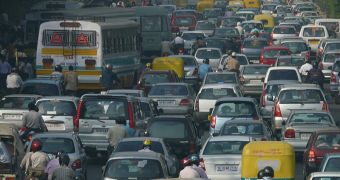Cars tend to meet much less drag if they are going forward in so-called platoons, rather than on their own, a new survey from Jadavpur University in Kolkata, India, shows. However, this statement comes to contradict everything drivers were told while in driving school.
One of the first things a future driver learns is that one needs to keep a safe breaking distance from the cars in front and at the back of the vehicle one is in. However, Debojyoti Mitra and Asis Mazumdar in the Department of Mechanical Engineering at Jadavpur University claim that the only way to minimize fuel consumption and crowding on the streets without building new freeways is to group cars tightly together while moving forward with speed.
With traffic on the rise in all major countries and with the emergence of markets like China and India, the number of cars that take to the road each year is growing exponentially. In Great Britain alone, the number of vehicles is set to double in the next decade, after jumping from 26 to 33 million over the past ten years. According to traffic experts, the current level of infrastructure growth is unsustainable. That means that even if new highways were to be constructed every year, they still wouldn't be able to keep up with the sky-rocketing number of cars, trucks, motorcycles and other vehicles.
One of the few existing possibilities for implementing a “platooning” system on the roads is to automate the system, meaning that the speed of all cars would be regulated by a central mainframe, which would dictate speed and corresponding lanes. The researchers who concluded this survey studied sets of 1 through 4 cars, in an attempt to determine where the most drag applied.
While it is true that the front car has no advantages as far as gas consumption or emissions go, the other have less and less drag coefficients, increasing their fuel economy and eliminating the swirls of air that are created behind every moving object. Just to give an example, Formula 1 cars use the same technique, called “aspiration,” to divert the flow of air coming from behind the opponent and use it as their own. The same is to be applied on highways, only at much lower speeds.

 14 DAY TRIAL //
14 DAY TRIAL //